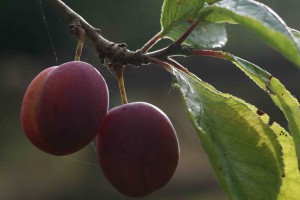
As torrential rain washes away the last remnants of summer so the remains of this years’ bumper crop of plums moulder and fall to the ground. But not before we have managed to gather bucket loads. It has been a wonderful year for all fruit in the garden despite the weather and the plums have been no exception. The orchard overflowed with the unique Dit’sum plum, boughs weighed down to the ground by the prolific harvest. Soaked grandchildren staggered into the kitchen with load after load as I looked on bewildered wondering what I could find to do with such a bounteous crop.
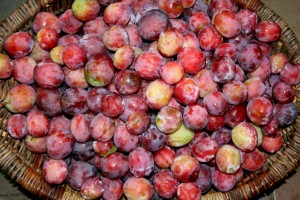
Years go by with no plums: a cold spring destroys the blossom, early rain rots the unripe fruit, silver leaf disease rampages through the orchard attacking tree after tree. Then once in a while we are overwhelmed by pounds and pounds of beautiful reddish purple fruit.
The plum as we know it today, prunus Rosaceae domestica, has been growing across Europe and Asia, Syria and Iraq, since before Roman times. Plum stones have been found in the ancient tombs of Damascus and in the 3.400 year old tomb of Kha, Egytian architect of Thebes. Pliny talks of “ingens turba prunorum”; great crowds of plums in Roman orchards. The mischievous Roman satirist and poet, Marcus Valerious Martialis (38-104 AD), wrote of plums as “frigida sunt, laxant, multum prosunt tibi pruna”; “Plums are cold, relaxing to the stomach and very good for you!” We all remember those school prunes and custard!
In the middle Ages we hear of the dark damask plums of Tours and Brignoles in France, for-runners of the famous Agen prune, and the bittersweet prunus salicina from Japan introduced to the United States in the late nineteenth century, a small fruit, delicious raw and used in sweet sour pickles as well as Sumomo Shu, a plum liqueur. In his 1949 book “Plums of England” H.V. Taylor cites 26 varieties which, according to John Rogers, a London Nurseryman, formerly of the Royal gardens, are the most “esteemed varieties grown in the gardens in 1834”. Among those listed are the greengage, common damson, and the red and white Magnum Bonham. The varieties of plum are legion.
Then there is, of course, our famous Victoria plum similar in appearance to the Dit’sum Ploughman though not as delicious and definitely not regarded with delight by Jane Grigson who describes it as “the apotheosis of a long reign in a flood of bland boring plums. Poor Victoria. She began life in 1840, a stray seedling found in Sussex and introduced by a nurseryman in Brixton……Victoria’s are for plums and custard, that crowning moment of the school, hospital, prison and boarding house midday meal” She continues that Mr Bird invented his custard powder around the same time “a Pooteresque menage a trois” of plum, nurseryman and custard inventor! I cannot agree that Victorias are quite that bad but there is no doubt our own Dit’sum plum has a superior flavour!
But what is the origin of this very local Dit’sum Ploughman plum growing only in Dittisham on the banks of the river Dart in South Devon? As I dug deeper into numerous books and the internet the answer became more and more obscure. Village myth or rumour has it that a German ship was wrecked off the coast near the mouth of the river carrying a cargo of trees or, maybe, prunes. Washed up on the village quay, barrels of prunes or maybe trees were collected by the villagers. This may be why the plums are also said to be related to the German “fluegal” plum. Interestingly the trees are raised from suckers and not grafted or budded which may be why they became unique to the valley. There is no doubt that the village plum crop was once prolific and the plums were sold in Brixham, Paignton and Torquay taken from the village by donkey cart and ferry across the river.
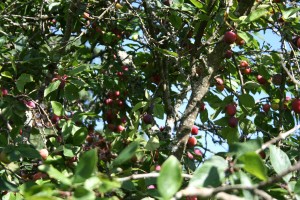
The plum was registered at Brogdale, home of the National Fruit Collection in 1949. They were kind enough to send me the limited information they have on record:
“Thank you for your enquiry on the Ditsum plum (listed as Dittisham Ploughman in the National Fruit Collection). There are currently 325 varieties of plum in our Collection, of which we maintain two trees of each. The majority of the information we keep on file for the different varieties relates to tree and fruit characteristics which helps for comparing and identifying varieties. For example, the notes on the Dittisham Ploughman fruit include: Season: early to mid-August Size: medium to large Shape: oval-oblong, slightly unequal sides, slightly flattened on suture; slightly tapering to base, slightly flattened at base, standing; slightly tapering to apex, slightly flattened at apex, not standing. Stalk: medium to medium long, 11-16mm Av.15mm; medium to slender, hairy, fairly conspicuous; inserted in a medium to deep cavity Flavour: sub acid; moderately sweet; little rich”
There is no doubt that, whatever their mysterious origin, they are beautiful plums. They have an excellent flavour straight from the tree and great setting quality for jams, jellies and puddings.
Delicious recipes abound. I will be trying Josceline Dimbleby’s Plums in Red Wine Syrup; sounds so simple and delicious. Simply stone the plums then make syrup of sugar, red wine and the juice of an orange and a lemon. Pour the thick syrup over the plums and leave to stand for a few hours. Serve with cream. And I love the sound of Nigel Slater’s Plum Crisp, a sort of cinnamon plum crumble but with“rubble” of breadcrumbs and butter to make the crispy topping. Some of my frozen plums will certainly be transformed into this on cold winter days to come.
Povidle
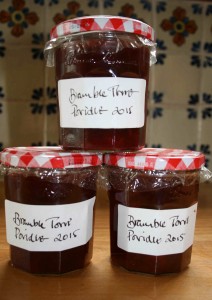
I have already made some of this year’s glut into an East European soft plum jam similar to fruit cheese called “Povidle”. The recipe is remarkably similar to the plum jam recipe made with Orlean or Magnum-Bonham plums in my 1880 edition of Mrs Beeton.
Stone and chop 2kg of purple plums. Layer the plums in a preserving pan with1kg of sugar.
Cover with a cloth and leave for a few hours until the juices start to run. Then bring the mixture gently to the boil, stirring until the sugar is melted. Simmer for 1 to 2 hours stirring occasionally until thick and dark.
Ladle into hot sterilised jars and seal in the usual way. The jam can be eaten immediately but improves with keeping.
Plum Jelly
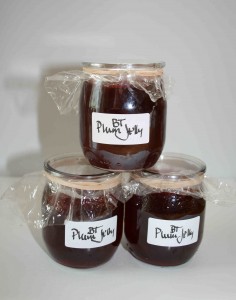
Stone and chop the plums. Put in a preserving pan and add a little water not quite covering the fruit. Bring to the boil, then simmer till the fruit is cooked and breaking up. Tip the fruit puree into a jelly bag and allow it to strain overnight. I use a piece of muslin on an up-turned stool! Do not be tempted to speed up the process by pressing the fruit; this will result in cloudy jelly!
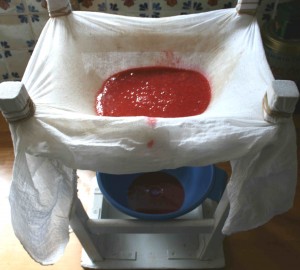
Tip the red juice into a measuring jug and allow 500ml of fruit to 500g of sugar (i.e. equal amounts) Now return both to the pan and boil to setting point. A good way to test for setting is to spoon a tiny bit of the jelly onto a saucer and put it in the ice box of the fridge for a few minutes till chilled. If when you touch it, it wrinkles across the top, your jelly is ready to put into hot sterilised pots.
Plum Chutney: The Constance Spry Cookery Book 1964
2lbs plums 1tsp salt 1/2lb apples
2 cloves crushed garlic 1lb seedless raisins chillies, fresh or dried
2 chopped onions ½ oz. allspice 1&1/2 pts vinegar
½ oz. ginger 1&1/2 lb brown sugar
Stone and chop plums. Chop raisins. Cook plums, apples, raisins, onion, garlic, chillies, allspice, and salt in 1 pint of the vinegar until soft. Pour the remaining vinegar over the sugar and put in a warm place to dissolve. When the fruit is cooked add the sugar and vinegar and continue cooking in an uncovered pan until thick and dark. Put into hot sterilised jars and cover. Although you can eat the chutney right away it does improve with keeping.
Bottled plums
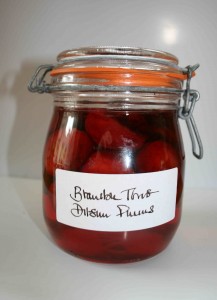
Prick the plums all over with a cocktail stick and pack into Kilner jars. Half cover with a spirit of your choice. Elisabeth David suggests cherry brandy and a vanilla “bean” (sic) for “an extraordinary haunting scent”. This year I decided to go east European again and try vodka. Top up and cover the plums with strong sugar syrup made with equal quantities of sugar and water. Seal the jars and put away in a dark cupboard for a couple of months.
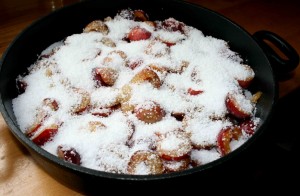
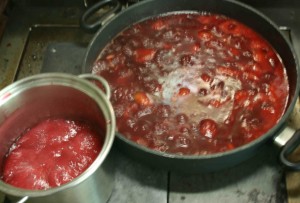
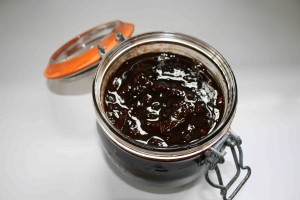
Leave a Reply